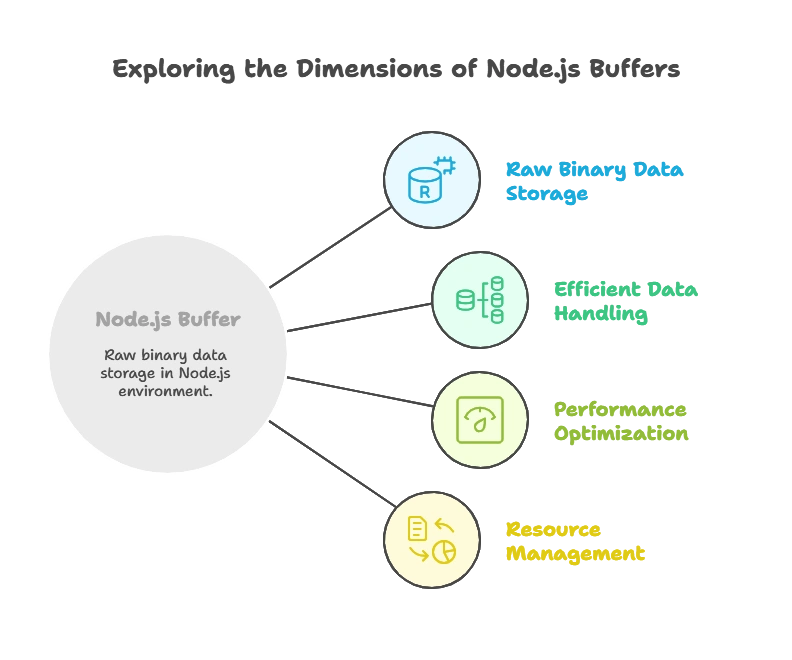Node.js Buffers
Node.js is a runtime environment that allows you to execute JavaScript on the server side. One of its powerful features is handling binary data using Buffers. Buffers are particularly important for dealing with binary streams and performing operations that involve binary data, such as reading from or writing to files, handling network packets, or working with cryptographic operations.
What is a Node.js Buffer?
A Buffer is a raw binary data storage in Node.js. It is similar to an array of integers but corresponds to a raw memory allocation outside the V8 heap. This is crucial for efficient binary data handling in environments like Node.js, where performance and resource management are critical.

Creating Buffers
Buffers can be created in several ways:
Allocating a new buffer of a specific size:
const buf = Buffer.alloc(10);
console.log(buf); // <Buffer 00 00 00 00 00 00 00 00 00 00>
This creates a buffer of size 10, filled with zeros.
Allocating an unsafe buffer:
const buf = Buffer.allocUnsafe(10);
console.log(buf); // <Buffer 80 8c 16 02 01 00 02 3d 80 70>
This creates a buffer of size 10 with uninitialized memory, which may contain old data.
From an existing array or string:
const bufFromArray = Buffer.from([1, 2, 3, 4]);
console.log(bufFromArray); // <Buffer 01 02 03 04>
const bufFromString = Buffer.from('hello');
console.log(bufFromString); // <Buffer 68 65 6c 6c 6f>
Writing to Buffers
You can write data into a buffer using the write method:
const buf = Buffer.alloc(10);
buf.write('hello', 0, 'utf-8');
console.log(buf); // <Buffer 68 65 6c 6c 6f 00 00 00 00 00>
Reading from Buffers
You can read data from a buffer using various methods:
const buf = Buffer.from('hello');
// Reading as string
console.log(buf.toString()); // 'hello'
// Reading as JSON
console.log(buf.toJSON()); // { type: 'Buffer', data: [ 104, 101, 108, 108, 111 ] }
// Reading individual elements
console.log(buf[0]); // 104 (ASCII code for 'h')
Buffer Methods and Properties
buf.length: Returns the size of the buffer.
const buf = Buffer.from('hello');
console.log(buf.length); // 5
buf.copy(targetBuffer, targetStart, sourceStart, sourceEnd): Copies data from one buffer to another.
const buf1 = Buffer.from('hello');
const buf2 = Buffer.alloc(5);
buf1.copy(buf2, 0, 0, 5);
console.log(buf2.toString()); // 'hello'
buf.slice(start, end): Returns a new buffer that references the same memory as the original.
const buf = Buffer.from('hello');
const slice = buf.slice(0, 2);
console.log(slice.toString()); // 'he'
buf.equals(otherBuffer): Compares two buffers.
const buf1 = Buffer.from('hello');
const buf2 = Buffer.from('hello');
console.log(buf1.equals(buf2)); // true
buf.fill(value, start, end): Fills a buffer with the specified value.
const buf = Buffer.alloc(5);
buf.fill('a');
console.log(buf.toString()); // 'aaaaa'
Advanced Buffer Operations
Buffer Concatenation
Combining multiple buffers into one can be done using Buffer.concat:
const buf1 = Buffer.from('Hello, ');
const buf2 = Buffer.from('world!');
const buf3 = Buffer.concat([buf1, buf2]);
console.log(buf3.toString()); // 'Hello, world!'
Buffer Encoding
Buffers can be encoded and decoded in different formats:
const buf = Buffer.from('Hello, world!', 'utf-8');
console.log(buf.toString('base64')); // 'SGVsbG8sIHdvcmxkIQ=='
Buffer to JSON
Buffers can be converted to JSON, which can be useful for debugging or transmission:
const buf = Buffer.from('Hello, world!');
const json = buf.toJSON();
console.log(json); // { type: 'Buffer', data: [ 72, 101, 108, 108, 111, 44, 32, 119, 111, 114, 108, 100, 33 ] }
Practical Examples
Reading a File into a Buffer
One common use case for buffers is reading files:
const fs = require('fs');
fs.readFile('example.txt', (err, data) => {
if (err) throw err;
console.log(data); // <Buffer ...>
console.log(data.toString()); // Content of the file
});
Writing a Buffer to a File
Similarly, you can write buffers to files:
const fs = require('fs');
const buf = Buffer.from('This is some data to write to a file.');
fs.writeFile('output.txt', buf, (err) => {
if (err) throw err;
console.log('The file has been saved!');
});
Buffers are a fundamental part of Node.js for handling binary data efficiently. Understanding how to create, manipulate, and use buffers will empower you to handle a wide range of tasks involving binary data, such as file operations, network communication, and cryptographic operations. By mastering buffers, you can optimize performance and resource management in your Node.js applications.Happy coding !❤️
